With the help of cold porcelain mass, you can make a worthy gift that will not be inferior in beauty and originality to store-bought analogues. Craft making instructions and master classes accessible even to novice craftsmen.
Who invented cold porcelain?
The history of cold porcelain originates in ancient China. The masters of that time created works of art using a recipe that was later used by the Danes and Russian craftsmen.
References to the use of cold porcelain in Russia date back to the beginning of the 19th century, when Pyotr Ulyanovich Ivanov, a master at the imperial porcelain factory, began to make the finest porcelain flowers using a special recipe to decorate perfume bottles, mirrors and vases intended for the emperor’s family.
What is good about this material for crafts?
Cold porcelain (crafts for beginners, step-by-step diagrams with descriptions are given further in the article) is a plastic mass with a smooth, uniform texture that hardens when dry.
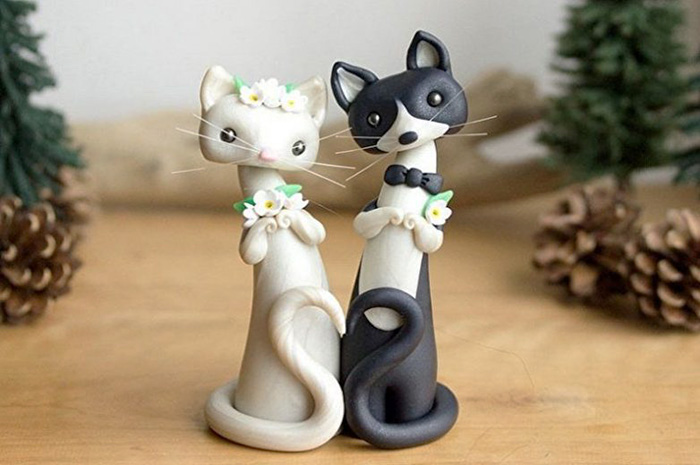
Ceramic products made of cold porcelain do not require heat treatment; they can be painted with varnish or paints.
To make the composition, you need the most affordable materials that can be bought in any store. The modeling mass has the best ratio of the price of ingredients and the quality of the resulting crafts.
Plastic porcelain is completely non-toxic and safe for children's creativity.
Working with it does not require special knowledge and skills. The art of making porcelain products is learned empirically from simple to complex.
What can be molded?
Porcelain crafts are distinguished by their beauty and elegance. The plastic mass can be used in various areas.
The most popular products made using the modeling technique are the following:
- costume jewelry (pendants, earrings, bracelets);
- hair decorations (hairpins, decorative elastic bands, headbands);
- interior items (decorative flowerpots, boxes, vases, lamps);

- cartoon characters, animal figurines, insects, people;
- gift souvenirs;
- decorative ornaments for vases, mugs, flower pots, wall panels;
Master class for beginners on making the mass with your own hands
Cold porcelain (it is recommended to make crafts for beginners from a simple mixture without heat treatment) has several variations of recipes. They differ in components and method of preparation.
Recipes without heat treatment
Recipes for preparing modeling clay are divided into 2 types: with and without heat treatment.
At the same time, the finished mixture does not differ in consistency and quality.
To prepare the mass in a classic way, you will need to do the following:
- Mix 4 tablespoons of any starch with 2 tablespoons of vegetable oil and add 5 drops of glycerin.
- Add a little soda (on the tip of a teaspoon) and 4 tablespoons of PVA glue to this mixture.
- Mix the mixture very thoroughly. At first, you can stir it with a spoon. When the mass thickens, start kneading it with your hands.
- Before sculpting, roll the “dough” into a ball, grease it with rich cream and place it in a plastic bag for 3-4 hours.
Recipes with heat treatment
Thermal processing in the creation of plastic mass involves the use of heating on a stove or in a microwave oven.
The simplest and most accessible recipe consists of only 3 components:
- baking soda - 1 part;
- starch - 1 part;
- water - 1 part.
Method of preparation:
- The listed ingredients should be poured into a frying pan with high edges and mixed thoroughly.
- Then, begin to heat the mixture over low heat, stirring constantly.
- When a lump forms, you need to thoroughly knead it with your hands for 2-3 minutes.
The resulting composition has a uniform, dense consistency. The mass is plastic, but not stretchy. It is well suited for sculpting figures.
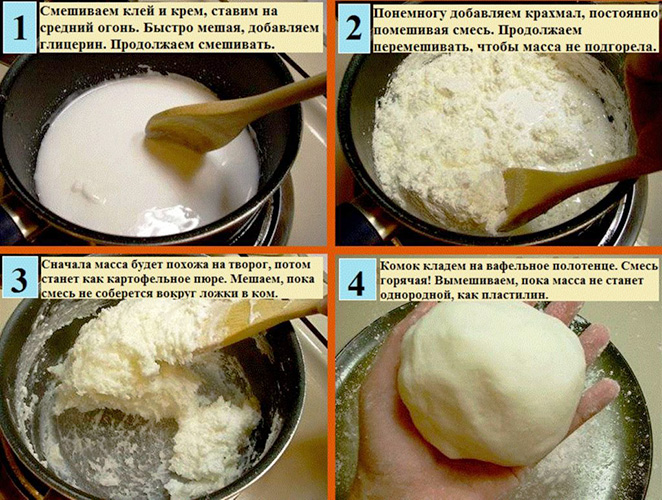
Another option is more complex, but products made from this mass are elastic even when dry.
Ingredients required:
- starch;
- PVA glue;
- baby skin care oil;
- lemon juice (wine vinegar);
- rich cream for skin.
To make cold porcelain you need to do the following:
- Mix the ingredients in the following quantities: 1 tbsp. of starch and PVA glue, 2 tbsp. of baby oil and lemon juice.
- Place the mixture in the microwave for 25 seconds and stir well again.
- Repeat heating 2 more times.
- Next, knead the mixture for at least 5 minutes using your hands.
- Treat the resulting mass with a rich cream, wrap it in plastic and put it in the refrigerator.
- Use cold porcelain no earlier than after 3 hours.
How to whiten plastic porcelain?
The whiteness of porcelain directly depends on the color of the ingredients.
If the mass turns out yellow or beige, it can be bleached using the following method:
- Knead the mixture according to the classic recipe with cooking in the microwave (2 tbsp. of starch and PVA glue, 1 tsp. of glycerin and lemon juice, 1/4 tsp. of paraffin, Vaseline and baby body oil).
- Add 1 teaspoon of oxygen bleach powder or a spoon of liquid detergent to the ingredients.
- Cover the mixture with plastic and leave for 2-3 hours to bleach.
- Cook the mixture in short intervals (5-6 seconds) with constant stirring until the mixture thickens.
How to fix cooking errors?
If it happens that during cooking the mass overheats and becomes crumbly or, on the contrary, the porcelain is not dense enough, You can use the following recommendations:
- If the dough turns out too runny when preparing the classic recipe, you need to add a little starch.
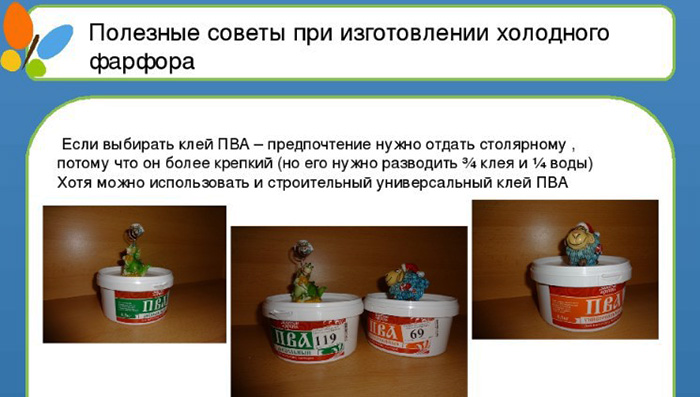
- Many craftsmen categorically advise against diluting the mixture with water. If the mass is crumbly, it is recommended to add PVA glue.
- To make the modeling clay plastic and to keep it elastic even after drying, paraffin should be added to the composition.
Coloring
Cold porcelain (crafts for beginners do not require special skills in production) can be both colorless and colored. Depending on the type of product and the intensity of the color of the craft, various painting techniques are used.
You can mix the pigment directly into the plastic mass, or you can paint the finished product after it dries.
The table shows the main methods of tinting the modeling mass:
| Method of application | Dyes |
| Surface tinting of the finished product |
|
| Colouring of modelling clay (mixing pigment into plastic composition) |
|
Drying of finished products
Compliance with drying rules is the key to success and obtaining a beautiful product. Depending on the size and thickness of the craft, different drying times may be required.
It is worth remembering that some elements are quite thin (flower petals, leaves) and to maintain their shape they need to be placed on the base at a certain angle and with the required bend. Thus, rosebuds are conveniently dried in the cells of egg trays, and to give graceful bends to leaves and petals, they can be laid out on the spread of a book, previously covered with foil.
The average drying time for cold porcelain crafts is 24 hours at room temperature. In this case, for uniform drying, the products must be turned over.
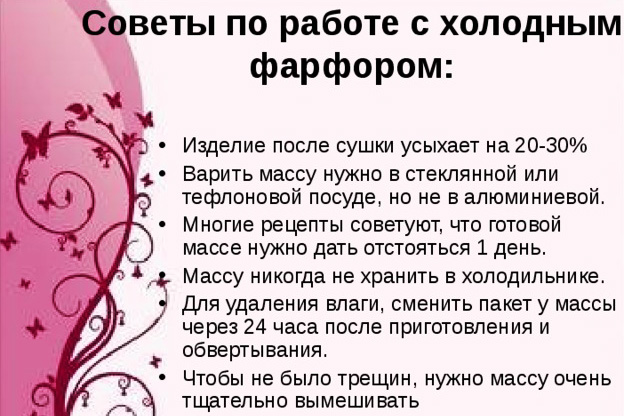
To speed up the drying process, you can use the following method: heat the oven, turn it off and place the porcelain crafts inside.
Sculpting tools
For modeling, it is necessary to prepare a workplace with good lighting, cover it with film or a special mat for creativity. It should be taken into account that the modeling mass absorbs any dirt very well, so the work should be done with clean hands. If necessary, it is recommended to periodically wipe your hands with wet wipes.
To work with cold porcelain you will need special tools and auxiliary materials:
- A rolling pin for rolling out large sheets of porcelain;
- Stacks of different shapes for rolling, cutting, creating corrugated edges, holes and textures on the surface of blanks.
- Scissors (large and small).
- Tweezers with different tips.
- Wire cutters.
- Wire for creating flower stems and other structures.
- PVA glue for assembling products.
- Dyes for tinting the mass.
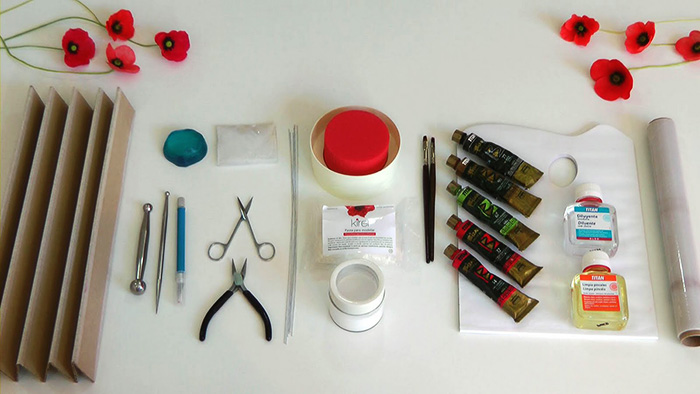
Beautiful crafts from cold porcelain. Step-by-step description of the molding process
Cold porcelain has an undeniable advantage: when it dries, it becomes hard. Therefore, even children and novice craftsmen can make crafts that will serve as original gifts for friends and family.
Flowers
A simple master class on making spring crocuses will appeal to both beginners and experienced craftsmen.
To work, you need to prepare the modeling mass and paint it in 3 colors: purple, yellow and green. You will also need molds for cutting out petals (you can make them yourself from a tin can) and wire for making stems.
To create flowers you need:
- Roll out the porcelain mass on a flat surface into a layer the thickness of which is exactly 2 mm.
- Using a mold, cut out the petals (you will need to make 6 petals for each flower).
- To give the petals a pattern, you need to press them against a textured surface or special molds.
- Place the molded petals on plastic spoons to dry.
- Make stamens and pistils from the yellow mass. For the pistils, cut a thin layer into small triangles. Cut one edge of the triangle with thin scissors and then roll it into a tube. For each flower, make 3 pistils and 3 stamens.
- Wrap the wire for the stems with electrical tape. Attach all the flower elements to the stem (pistils and stamens in the center, petals in 2 rows around).
- The stems and receptacle are made of green porcelain.
- To dry, hang the flowers upside down.
- Make long leaves from green plastic mass.
- Place the finished flowers in a vase or collect them into a bouquet.
Other flowers can be made in the same way. The difference lies in the shape, size and number of petals.
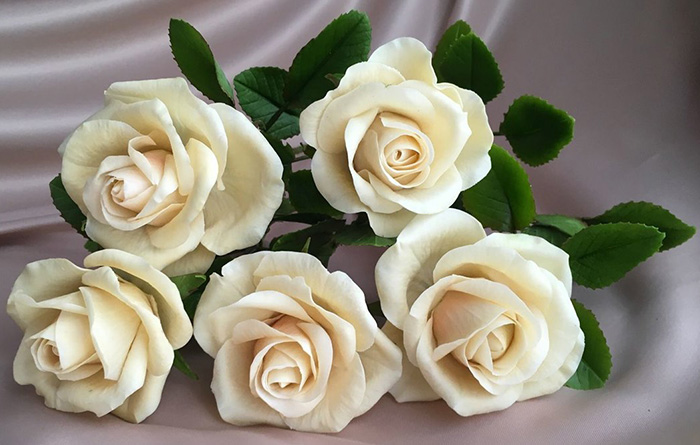
Lush lilac inflorescences made of lilac porcelain look very natural. To create them you will need scissors, tweezers and wire.
To make a flower, you need to roll a small ball, form a drop-shaped figure and use scissors to cut the thickened part into 4 segments. You can shape the petals with tweezers. To create unopened buds, you only need to slightly press the drop from the mass with the blades of the scissors.
Flowers need to be collected on a prepared base by placing each flower on a wire.
Bijouterie
Cold porcelain (crafts for beginners can have simpler schemes) is a very flexible material that lends itself to modeling. In creativity, you can combine any colors, which is suitable for creating bright jewelry.

A bracelet with pink pearls and small peach-colored inflorescences will look incredibly gentle. To make it, you will need to make about 30 porcelain flowers. Any old bracelet with a chain base can serve as the basis for the bracelet.
Assembly order:
- You need to put a pink mother-of-pearl bead and a porcelain flower on the pin one after the other.
- Using round-nose pliers, bend the free edge of the pin into a ring.
- Make similar pendants without flowers from beads of different sizes.
- Assemble the bracelet by attaching pendants with flowers and beads to the chain one by one.
A pendant and earrings made in the same style from small rosebuds surrounded by delicate greenery will complement an elegant look or serve as a gift for a significant event.
A voluminous ring in the form of a lush peony can become a bright accent for an evening look.
To create it, you need to buy a ready-made ring base and make a flower from cold porcelain according to the following description:
- For the base, you need to put a small ball made of plastic mass on a toothpick.
- Next, you need to make the petals and sequentially attach them with glue to the central ball.
- The petals are made from small pieces of cold porcelain. First you need to roll a ball, then use a stack to roll it out on your palm.
- Without removing the petal from your palm, use a stack to make small cuts along the outer edges and roll it out lightly again.
- Place the petal on your index finger and use a stack with a ball on the end to give it a curved shape.
- The petals need to be strengthened sequentially in a circle, increasing their size each time.
- The flower must be dried and then glued to the ring blank.
Basketry
For a spring bouquet, you can make a wicker basket. This is a simple craft, suitable for beginners.
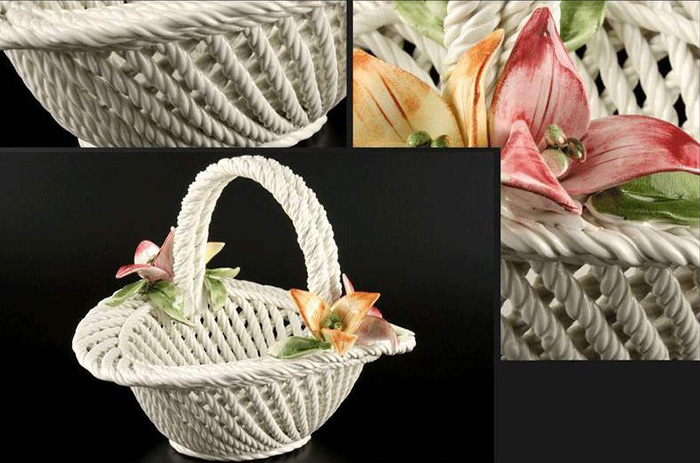
To make the craft, you will need to take the "dough" of the desired color. You can make a brown basket, or you can make an unusual pink or blue one. The manufacturing scheme comes down to weaving a basket from bundles rolled from a plastic mass.
Assembly sequence:
- For the base, you can use a small glass jar or other container.
- 13 pieces of bundles with a diameter of about 2-3 mm need to be laid out in a circle and their ends glued in the center of the bottom of the jar.
- Glue a circle of cold porcelain in the middle, which will serve as the bottom of the basket.
- After drying, remove the workpiece from the base and weave the rods in a circle.
- The top of the basket can be closed around the circumference with two rods twisted together.
- It is recommended to make the handle from wire wrapped with plastic tape.
Figurines
Both children and adults will enjoy making figures from plasticine. Their production is no different from modeling from plasticine, but the result will please you with the fact that they can then be used as toys.
In the same style, you can make various interior, garden figures, souvenirs, keychains and children's toys. Figures from plastic dough can be both simple and very complex, with many elements that can be equated to works of art.

Various materials can be used to decorate cold porcelain items. These can be beads, glass crystals, textile and metal elements.
New Year's crafts
The most popular type of New Year's crafts are Christmas tree decorations. It is very easy to make them from cold porcelain mass. To do this, you need to cut out figures from a layer of rolled mass, make holes for hanging, dry and paint.
To create New Year's figures, you need to use your imagination. The easiest way is to buy ready-made molds and cut out blanks with them. Or you can use improvised means to create themed decorations.
So, simple balls with snowflakes can be cut out using a simple glass, and an openwork pattern can be made using a knitted or plastic napkin, which must first be pressed onto the dough layer using a rolling pin. Holes for ties can be easily made using a cocktail straw. After drying, the relief pattern can be tinted with silver or gold paint.
To make decorations in the form of Christmas trees, simply use a knife to cut triangles from the rolled out mass, use a fork to make something like pine needles, and paint the toys green.
The snowman can be made from 2 circles of different diameters, glued to each other with a small overlap. The place where the circles are connected should be covered with a scarf, which is made from a strip of a bright color with fringe along the edges. The semblance of fringe is created using cuts with a knife or scissors. The nose, eyes and mouth are also made from a mass of different colors.
Decorating dishes
Porcelain mass is unstable to temperature changes, so it is not used to make dishes. But a decorative mug decorated with a floral composition can become an enviable item of kitchen interior.
To create a designer cup you will need:
- Bright rosebuds, forget-me-nots and leaves made from the mass.
- A green porcelain base on which the composition will be attached.
- Glue (for strength you can use E6000 glue).
The assembly order of the elements consists of the following stages:
- A base in the form of a spot of green porcelain needs to be glued onto the cup.
- Large flowers should be placed in the center.
- The perimeter of the spot must be filled with green foliage.
- Between the large inflorescences, you need to strengthen the smaller flowers and unblown buds.
- The top of the composition can be decorated with a bouquet of blue forget-me-nots with a bright yellow center.
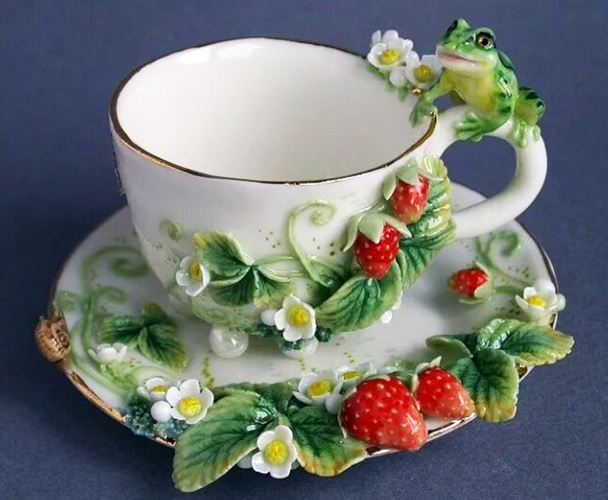
As a gift, you can present a tea set decorated with scarlet poppies and bright greenery. Fans of feasts will appreciate salt shakers, sugar bowls and other kitchen utensils decorated with flower arrangements.
Decorating photo frames
A photo frame has always been an appropriate gift for any holiday. A stylish handicraft made with your own hands can become an independent element of a designer interior or simply serve as an object for storing family memories.
Photo frame design options:
- A photo frame in a marine style, decorated with shells and starfish, made in white and blue tones.
- Children's photo frame with cute figures of cartoon characters and children's household items (baby bottles, pacifiers, rattles).
- A stylish interior accessory with large inflorescences of roses, peonies, lilies and hydrangeas.
The availability of ingredients and ease of manufacture make the mass for cold porcelain a leader in decorative and applied art. The methods of modeling are available to children and craftsmen who are just beginning their creative work.
Author: Maria Andryukova
Video about cold porcelain:
Tips for beginners on cold porcelain modeling:
